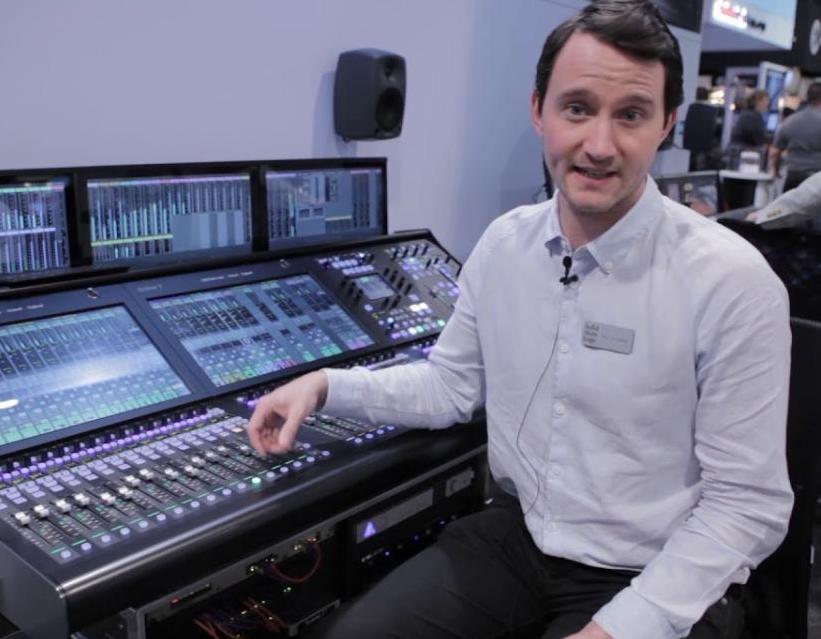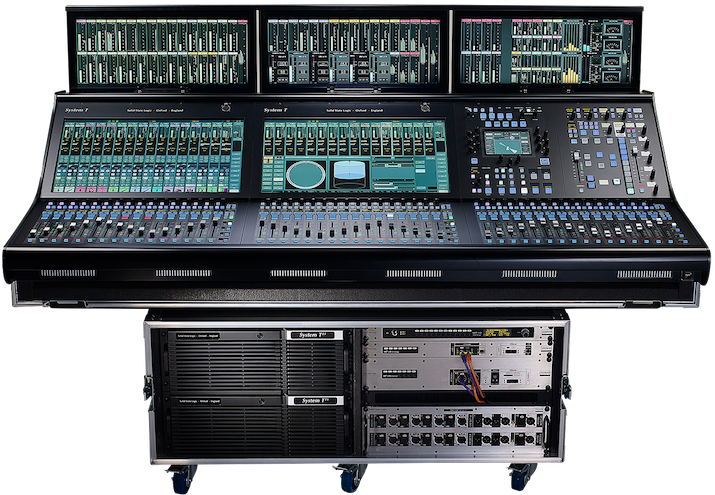Tech Focus: Immersive Audio, Part 1 — Infrastructure Waits Out the Pandemic
New consoles and microphones are ready to meet the demand
Story Highlights
Comcast Xfinity subscribers (at least those equipped with eligible X1 devices) were able to access what might be the next plateau of next-generation television during last summer’s Olympics broadcasts from Tokyo: a combination of Dolby Vision HDR video and Dolby Atmos immersive audio. That pairing was used to present the Opening and Closing Ceremonies, as well as popular sports — gymnastics, track and field, swimming, diving, beach volleyball, golf, tennis — during primetime broadcasts.
Comcast-owned NBC Sports has also taken a lengthy lead in applying immersive sound for domestic sports. For instance, the Peacock Network had been providing Dolby Atmos immersive audio on its Notre Dame Football home games for three years as part of a package with 4K video. More recently, the 2019 U.S. Open golf tournament was produced with an immersive 5.1.4 audio mix: surround sound (5.1) plus four height speakers (.4).
Immersive audio didn’t take a break during the pandemic lockdowns. For instance, the UK’s Sky Sports used Dolby Atmos throughout Project Restart, the return of football to television, broadcasting Premier League and English Football League (EFL) matches.
Immersive audio has become an integrated element in a range of high-profile broadcast-sports proof-of-concept projects. Through them, the format has been increasingly finding its way out of an industry bubble so that more viewers can access it — although, for the present, it remains largely an experiment.
Pathway Pioneered by Other Media
As is often the case, other pro-audio sectors — typically, music and film/television production and postproduction — tend to lead the way in new sonic technologies, and that has been the case with immersive audio. Those sectors become test cases and proving grounds for wider adoption.
Cinema has been the main field for immersive sound, with music making a more assertive case for it (Apple Music announced its Dolby Atmos–powered Spatial Music format in May). Live productions have also been making use of the technology, with leading sound-system developers L-Acoustics and d&b audiotechnik (both supplying PA systems for sports venues) bring immersive live-sound systems to market.

Dale Pro Audio’s Joel Guilbert: “There will be studio infrastructure to support creating great-sounding immersive content in the future.”
“This past year has seen more adoption in the postproduction and music for immersive audio,” says Joel Guilbert, technology development manager, Dale Pro Audio. “As these technologies start to become more mainstream in their implementation and reach a greater consumer base, demand continues to rise. Once again, sports broadcast led the pack when it came to live production, and, as a side effect, there will be studio infrastructure to support creating great-sounding immersive content in the future.”
And the tools for immersive sound are now more widely available and increasingly affordable.
“Although they are still more specialty items,” says Guilbert, “we’ve found that, as more [manufacturers] enter the immersive market and with different approaches, like the Studio Technologies 792/3 [an audio-over-IP–enabled multichannel monitoring system] and the Focusrite R1 [a Dante, Pro Tools, and Thunderbolt system-monitoring interface supporting up to eight channels], this area is starting to be more competitive. The addition of those devices, all three having eight-plus–channel monitor/control capabilities, increases the number of professional tools available by a third.”
On the Worksurface
Immersive sound is part of the Next Gen Audio initiative, part of the ATSC 3.0 portfolio, whose audio standards allow full 7.1+4 implementation — up to seven channels of sound in a horizontal plane (although five have been most common), one channel for a subwoofer, and four channels overhead.
To handle that workflow, consoles have been working toward accommodating immersive audio for some time. For instance, Calrec’s Impulse Core, the next-generation audio-processing platform for its Apollo and Artemis control surfaces, can accommodate 5.1, 5.1.2, 5.1.4, 7.1, 7.1.2, and 7.1.4 formats in terms of input channels, buses, monitoring, and metering. Lawo’s A__UHD Core immersive system, introduced at IBC 2018, can address immersive mixing configurations up to 22.2 and offers different levels of remote-operation functionality.
An immersive-audio feature set was added to Solid State Logic’s System T broadcast desk as part of a software release in 2018 and will continue to be updated. SSL Product Manager, Broadcast, Tom Knowles agrees that marquee-type events will help propel immersive audio into that realm but adds that the company is offering to help encourage it on the business side. This year’s System T V3.1 software release introduces pay-as-you-go licensing that enables operators using the new TE1 and TE2 Tempest Engines to flexibly scale processing capabilities according to broadcast-production requirements. Software licenses for five different processing packs, defined by the total number (from 85 to 800) of mono-signal-path–equivalent channels supported, are now available as ongoing or short-term, time-based rental upgrades.

Solid State Logic’s Tom Knowles sees the growing integration of immersive audio into live sound systems.
“It’s essentially added DSP capability on an as-needed basis, which is perfect for broadcasters when they need to scale up for an event with immersive audio,” Knowles explains, adding that it’s well-matched to broadcast’s cautious budgeting. “An occasional event might need to support 5.1.4 with overhead speakers, but that huge extra processing capacity would just sit there when it’s not needed. With this, they rent the additional channel counts as needed.”
He also acknowledges the growing integration of immersive audio into live sound systems, noting that SSL’s Live series of FOH consoles currently offers integrated control of L-Acoustics’ L-ISA and Meyer Sound Lab’s Space Map Go immersive formats.
There is a significant difference between broadcast and live immersive technologies, particularly when it comes to channel counts. “But there are also similarities,” he adds. “We’ll see if that turns into synergies.”
Lawo Senior Product Manager, Audio Production, Christian Struck confirms that requests for intuitive immersive/next-gen audio-mixing solutions are on the rise again.

Lawo’s Christian Struck: “We expect thorough support for immersive to become a must-have over the course of 2022.”
“Immersive sound is the perfect sonic complement for 4K picture quality,” he says, “and so our customer base is in the process of moving it back from its backburner status to the appreciated-feature list. We expect thorough support for immersive to become a must-have over the course of 2022.”
Struck emphasizes that the software-defined nature of the A__UHD Core allows Lawo to meet its customer base’s immersive-sound expectations on relatively short notice, with broadcasters adding processing resources on an event-by-event basis. For instance, he suggests that its use, currently limited to Opening and Closing Ceremonies and to finals of major sports events, will be extended to the entire events in the future.
The approach is very similar to the one in place for Lawo’s V__matrix platform, for which the company recently announced a new set of enhancements, he says, adding that the main features for audio consoles in an immersive workflow — such as high channel counts and the busing, monitoring, and mixing infrastructure to support them — will become available in 2022.
“A growing number of VoD streaming providers already produce new material directly in immersive audio formats and are in the process of upmixing or remixing their existing catalog,” he says. “This is a clear sign that immersive audio is finding its way not only into viewers’ homes but also onto their mobile devices.”
The Effect on Microphones
The use of more exotic microphones is also part of the immersive integration process. Specifically, multi-transducer surround mics, like the DPA 5100 mobile surround microphone, are showing up on more broadcasts in general, such as on cameras as a way to add an LFE channel to handheld shots. In some cases, they are replacing conventional shotgun microphones for Doppler shots in auto racing, where they can boost low-end sound by eliminating proximity-effect issues.
These types of microphones have also become standard for European soccer broadcasts; they can set up a soundstage for the lengthy wide shots of a soccer pitch that are common in those productions. In some cases, a surround mic will be installed in stadiums in Europe, usually in the venue rafters and pointed downward, to create sonic surround baseline sound. That’s rarely the case in the U.S., where most broadcasters bring their own, mostly conventional microphone complements to remote broadcasts.
Smart TVs are beginning to incorporate more immersive-sound capabilities, and immersive soundbars are becoming even more readily available in the home, suggesting that immersive sound will be part of broadcast-sports audio’s next frontier. However, as more than a decade’s worth of broadcast 5.1 surround has shown, cutting-edge audio formats tend to have relatively minimal impact on most consumers, even as they compel systems manufacturers to accommodate ever increasing channels, and broadcasters to handle the bandwidth to push them through. Even 2.1 audio — stereo with a separate subwoofer channel — is still a relative luxury for most home viewers. Therefore, broadcast audio’s immersive future for televised sports will likely remain a chicken-and-egg paradox for some time to come.
Click here for Tech Focus: Immersive Audio, Part 2 — Surround Microphones Come of Age.
Click here for Tech Focus: Immersive Audio, Part 3 — Consoles Evolve as Software-Based Solutions

